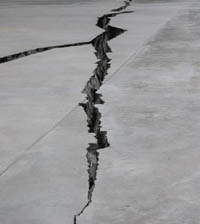 Why does concrete crack?
Why does concrete crack?
Unlocking the mysteries of a critical building resource
 Concrete has been the main stay of building construction for generations. Today, traditional reinforced concrete is an integral and important component of building structures. It usually takes the form of footings in ground, slabs on ground, columns and suspended slabs.
Concrete has been the main stay of building construction for generations. Today, traditional reinforced concrete is an integral and important component of building structures. It usually takes the form of footings in ground, slabs on ground, columns and suspended slabs.
Concrete however, is not the perfect substance. As such it can suffer from defects. These defects can have a huge impact on the appearance, capital expenditure, maintenance costs, safety and effective life of the total structure.
What then are the typical forms of concrete defects? Some of the more common defects can be categorised as follows:-
-
Structural design inadequacies – distortion, bending cracks, deflection, shear cracks, impact damage temperature change cracks, abrasion, torsion cracks and erosion.
-
Environmental causes – weathering/staining, biological growth, bacteriological attack, efflorescence (lime leaching), freeze-thaw damage and fire damage
-
Aggregate properties – aggregate swelling/shrinkage/softening, alkali-silica reaction and sulphide staining/spalling.
-
Chemical attack – sulphates, chlorides, acids and salt weathering.
-
Reinforcement corrosion – cracking, spalling and de-lamination
-
Concrete Cancer – cracking of the concrete caused by the corrosion of steel reinforcement in concrete structures
These defects are a significant worldwide problem and cause multi-billion dollar losses to infrastructure and building owners annually.
Reasons for the rectification of concrete defects can range from purely subjective (the aesthetics); to preventive (to prevent additional damage); to structural (preventing partial or complete failure); to safety (avoiding impact from falling debris).
As evidenced by the recent traffic disruption caused by structural cracking on the Riverside Expressway in Brisbane, one of Australia’s busiest stretches of road, the consequences (time, distraction and expense) of cracking concrete can be severe.
What then is the solution to problems caused by cracking concrete? The type of concrete defect rectification varies with respect to a number of factors: budgetary constraints, time limitations, weather conditions, and the requirement for specialised techniques.
In the specific case of concrete cancer, cracked concrete is removed followed by cleaning, treating and replacing any rust affected steel. The area is then repaired to the original concrete profile using cement mortar, epoxy mortar or concrete. This depends on the size of the damage and the structural requirement. Cracks are repaired using suitable epoxies, special mortars and injection techniques
While the rectification processes are usually expensive and time consuming, they are nevertheless an important step to take. Cracked concrete can have severe consequences, and if remain unchecked, associated costs can escalate significantly from both a repair, and damage control perspective.
